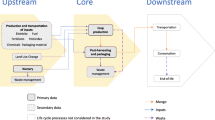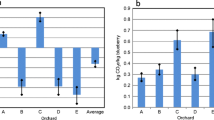Abstract
Purpose
The assessment of the carbon and water footprints of agricultural products is important for fruit producers because it enables improvements in environmental management along the production chain as well as the opening of new markets. This study analyses the carbon and water footprints of green coconut produced in seven farms located at the main producing States in Brazil (Ceará, Alagoas, Sergipe and Bahia), investigating opportunities for reducing these footprints.
Methods
The carbon footprint was calculated based on ISO 14067 and the water footprint, on ISO 14046. Primary data were collected from orchards with dwarf coconut trees, located in the states of Ceará (CE1, CE2, CE3 and CE4 farms), Alagoas (AL farm), Sergipe (SE farm) and Bahia (BA farm). The impact categories considered and their assessment models were as follows: (i) for the carbon footprint, climate change impact was assessed (ILCD midpoint); (ii) for the water footprint, water scarcity (AWARE), human toxicity, cancer, non-cancer, and freshwater ecotoxicity and marine and freshwater eutrophication (ILCD midpoint) were assessed. Sensitivity analysis was performed for variations in emissions from land use change (LUC) and water scarcity characterization factors. Uncertainty analysis was applied to identify best performing farms and their practices.
Results and discussion
The farms that resulted in lower footprints (AL and CE4) caused less carbon losses in LUC and used less nitrogen fertilizers and irrigation water. LUC emissions answered for one third of coconut carbon footprint when orchards were installed in areas with Caatinga vegetation. However, if coconut orchards replaced annual crops, carbon footprint may reduce up to 61%. Regarding water scarcity, in the case of applying monthly AWARE factors, the impact increased as much as 95% in relation to impacts calculated using annual factors. The use of regionalized annual or monthly AWARE factors increased impact up to 97% in relation to when annual and monthly AWARE were used.
Conclusions
The analysis of alternatives for footprint reduction showed that both footprints can be reduced in all regions with changes in orchard lifespan, irrigation and fertilization. Increasing the useful life of the orchard results in a reduction of up to 38% in footprints, adjusting irrigation, up to 49%, and the amount of fertilizer, up to 70% of the carbon footprint and up to 82% of water footprint profile. Regionalized factors were more accurate for identifying critical watersheds for coconut production.









Similar content being viewed by others
References
Andrade EP, Nunes ABA, Alves KF, Ugaya CML, Alencar MC, Santos TL, Barros VS, Pastor AV, Figueirêdo MCB (2019) Water scarcity in Brazil: part 1 - regionalization of the AWARE model characterization factors. Int J Life Cycle Assess 1:1–17
Aragão WM, Ramos SRR, Alves MCS (2016) Coconut plantations. In: Fontes HR, Ferreira JMS (ed) The culture of the coconut tree. https://www.spo.cnptia.embrapa.br. Accessed 25 Apr 2018.
Basset-Mens C, Vannière H, Grasselly D, Heitz H, Braun A, Payen S, Koch P, Biard Y (2016) Environmental impacts of imported and locally grown fruits for the French market: a cradle-to-farm-gate LCA study. Fruits 71(2):93–104
Brazilian Institute of Geography and Statistics (IBGE) (2018) Municipal agricultural production in 2016. Brazilian Institute of Geography and Statistics, IBGE
Brazilian Institute of Geography and Statistics (IBGE) (2020) Municipal agricultural production in 2019. Brazilian Institute of Geography and Statistics, IBGE
Boulay AM, Bare J, Benini L, Berger M, Lathuillière MJ, Manzardo A, Margni M, Motoshita M, Núñez M, Pastor AV, Ridoutt B, Oki T, Worbe S, Pfister S (2018) The WULCA consensus characterization model for water scarcity footprints: assessing impacts of water consumption based on available water remaining (AWARE). Int J Life Cycle Assess 23:368–378
Carneiro JM, Dias AF, Barros VS, Giongo V, Matsuura MISF, Figueirêdo MCB (2019) Carbon and water footprints of Brazilian mango produced in the semiarid region. Int J Life Cycle Assess 24(4):735–752
Coltro L, Karaski TU (2019) Environmental indicators of banana production in Brazil: Cavendish and Prata varieties. J Cleaner Prod 207:363–378
Donke ACG, Novaes RML, Pazianotto RAA et al (2020) Integrating regionalized Brazilian land use change datasets into the ecoinvent database: new data, premises and uncertainties have large effects in the results. Int J Life Cycle Assess 25:1027–1042. https://doi.org/10.1007/s11367-020-01763-3
EPD (Environmental Product Declaration) (2019) Fruits and Nuts: Product Category (UN CPC 013). Available at www.environdec.com
Faist EM, Reinhard J, Zah R (2009) Sustainability quick check for biofuels: background report, Dübendorf
Figueirêdo MCB, Potting J, Serrano LAL, Bezerra MA, Barros VS, Gondim RS, Nemecek T (2016) Environmental assessment of tropical perennial crops: the case of the Brazilian cashew. J Clean Prod 112:131–140
Figueirêdo MCB, Inke de Boer JM, Kroeze C, Barros VS, Sousa JÁ, Aragão FAZ, Gondim RS, Potting J (2014) Reducing the impact of irrigated crops on freshwater availability: the case of Brazilian yellow melons. Int J Life Cycle Assess 19:437–448
Figueirêdo MCB, Kroeze C, Potting J, Barros VS, Aragão FAZ, Gondim RS, Santos TL, Imke de Boer JM (2013) The carbon footprint of exported Brazilian yellow melon. J Clean Prod 47:404–414
Food and Agriculture Organization (FAO) (2019) Quantity of coconut production by continent 2016. http://www.fao.org/statistics/databases/en/. Accessed 15 Aug 2019
Frischknecht R, Jungbluth N (2007) ecoinvent: overview and methodology. Swiss Centre for Life Cycle Inventories, Dubendorf
Giudice AL, Mbohwa C, Clasadonte MT, Ingrao C (2013) Environmental assessment of the citrus fruit production in Sicily using LCA. Ital J Food Sci 25:202–212
Goedkoop M, Schryver A, Oele M (2013) Simapro 7: introduction to LCA. PRé Consultants.
International Organization for Standardization (ISO) (2013) ISO 14067: greenhouse gases – carbon footprint of products – requirements and guidelines for quantification and communication. ISO, Geneva
International Organization for Standardization (ISO) (2014) ISO 14046: environmental management–water footprint – principles, requirements and guidelines. ISO, Geneva
International Panel on Climate Change (IPCC) (2007) Climate change (2007): synthesis report: contributions of working group I, II and III to the fourth Assessment Report. http://www.ipcc.ch/pdf/assessment-report/ar4/syr/ar4_syr_sppdf. Accessed 20 Nov 2017
Knudsen MT, Almeida GF, Langer V, Abreu LS, Halberg N (2011) Environmental assessment of organic juice imported to Denmark: a case study on oranges (Citrus sinensis) from Brazil. Org Agric 1:167–185
Kumar KSN, Maheswarappa HP (2019) Carbon sequestration potential of coconut based cropping systems underintegrated nutrient management practices. J Plant Crops 47(2):107–114
Marras S, Masia S, Duce P, Spano D, Sirca C (2015) Carbon footprint assessment on a mature vineyard. Agric For Meteorol 214–215:350–356
Martins CR, Jesus LA Jr (2014) Production and commercialization of coconut in Brazil and international trade: 2014 panorama. Embrapa Coastal Trays, Aracaju
Ministry of Science, Technology and Innovation (MCTI) [Ministry of Science Technology and Innovation] (2010) Brazilian Inventory of Anthropogenic Emissions by Sources and Removals by Sinks of Greenhouse Gases not Controlled by the Montreal Protocol. MCTI, Brasília
Ministry of Industry, Foreign Trade and Services (MDIC) (2018) Brazilian trade balance: States. http://www.mdic.gov.br/comercio-/estatisticas-de-comercio-exterior/balanca-comercial-brasileira-unidades-da-federacao. Accessed 13 July 2018
Miranda FR, Gomes ARM (2006) Coqueiro-Anão irrigation management. Embrapa Tropical Agribusiness Technical Circular 25:8
Miranda FR, Rocha ABS, Guimarães VB, Silva ES, Lima GCM, Santos MMS (2019) Water use efficiency in dwarf coconut irrigation. Irrig 24(1):109–124
Mordini M, Nemecek T, Gaillard G (2009) Carbon & Water Footprint of oranges and strawberries. Federal Department of Economic Affairs, Zurich, Switzerland
Nacional Institute for Colonization and Agrarian Reform (INCRA) (2020) Classification of Rural Properties. http://www.incra.gov.br/pt/credito/66-atuacao/234-classificacao-dos-imoveis-rurais.html. Accessed 15 Apr 2020
National Mango Board (NMB) (2010) Sustainability assessment: baseline assessment findings & recommendations. https://www.mango.org/wp-content/uploads/2017/10/Sustainability_Exec_Summary_Eng.pdf. Accessed 15 May 2019
Nemecek T, Schnetzer J (2012) Methods of assessment of direct field emissions for LCIs of agricultural production systems, Zurich
Nemecek T, Schnetzer J, Reinhard J (2016) Updated and harmonized greenhouse gas emissions for crop inventories. Int J Life Cycle Assess 21(9):1361–1378
Novaes RML, Pazianotto RAA, Brandão M, Alves BJR, May A, Folegatti-Matsuura MIS (2017) Estimating 20-year land-use change and derived CO2 emissions associated with crops, pasture and forestry in Brazil and each of its 27 states. Glob Change Biol 23:3716–3728
Oliveira JM, Ugaya CML (2019) Freshwater eutrophication. In: Ugaya CML, Almeida Neto JA, Figueirêdo MCB. Recommendation of life cycle impact models for use in the Brazilian context. Available in http://acv.ibict.br
Passos EEM (2016) Climate requirements for coconut trees. In: Fontes HR, Ferreira JMS. The culture of the coconut tree. https://www.spo.cnptia.embrapa.br. Accessed 24 Apr 2018
Ribal J, Estruch V, Clemente G, Fenollosa ML, Sanjuán N (2019) Assessing variability in carbon footprint throughout the food supply chain: a case study of Valencian oranges. Int J Life Cycle Assess 1:1–18
Roibás L, Elbehri A, Hospido A (2015) Evaluating the sustainability of Ecuadorian bananas: carbon footprint, water usage and wealth distribution along the supply chain. Sustain Prod Consump 2:3–16
Sampaio APC, Silva AKP, Barros VS, Amorim JRA, Miranda FR, Figueirêdo MCB (2018) Water footprint of green coconut water in the main producing regions of the Northeast. Latin Am Rev Life Cycle Assess (LALCA) 1:128–141
Santos TL, Nunes ABA, Giongo V, Barros VS, Figueirêdo MCB (2018) Cleaner fruit production with green manure: the case of Brazilian melons. J Clean Prod 181:260–270
Silva JJ, Dias TJ, Rolim HO, Lima LR, Júnior EBP (2014) Aerial biomass and estimated organic carbon in Coconut Agrosystem (Cocus nucifera, L.) irrigated green dwarf. Rev Green 9(1):01–07
Sobral LF (2016) Coconut manure. In: Fontes HR, Ferreira JMS (eds) The culture of the coconut tree. https://www.spo.cnptia.embrapa.br. Accessed 24 Apr 2018
Tassielli G, Notarnicola B, Renzulli PA, Arcese G (2018) Environmental life cycle assessment of fresh and processed sweet cherries in southern Italy. J Clean Prod 171:184–197
Vázquez-Rowe I, Torres-García JR, Cáceres AL, Larrea-Gallegos G, Quispe I, Kahhat R (2017) Assessing the magnitude of potential environmental impacts related to water and toxicity in the Peruvian hyper-arid coast: a case study for the cultivation of grapes for Pisco production. Sci Total Environ 601–602:532–542
Vinyes E, Asin L, Alegre S, Muñoz P, Boschmonart J, Gasol CM (2017) Life cycle assessment of apple and peach production, distribution and consumption in mediterranean fruit sector. J Clean Prod 149:313–320
Funding
Empresa Brasileira de Pesquisa Agropecuária (Embrapa) and Conselho Nacional de Desenvolvimento Científico e Tecnológico (CNPq).
Author information
Authors and Affiliations
Corresponding author
Additional information
Communicated by Stephan Pfister.
Publisher’s Note
Springer Nature remains neutral with regard to jurisdictional claims in published maps and institutional affiliations.
Supplementary Information
Below is the link to the electronic supplementary material.
Rights and permissions
About this article
Cite this article
Sampaio, A.P.C., Silva, A.K.P., de Amorim, J.R.A. et al. Reducing the carbon and water footprints of Brazilian green coconut . Int J Life Cycle Assess 26, 707–723 (2021). https://doi.org/10.1007/s11367-021-01871-8
Received:
Accepted:
Published:
Issue Date:
DOI: https://doi.org/10.1007/s11367-021-01871-8




